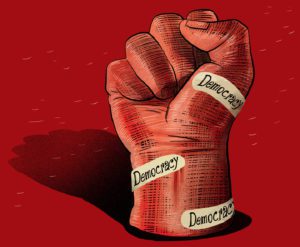Did you know that every map you’ve ever seen is incorrect?
Maps are responsible for a significant portion of our perception; from a young age we are taught the spatial distribution of the world around us through innumerable images of colorful maps. Not only that, but they are one of the earliest introductions to the countries and regions that exist around us and that are not our own – for many children, glancing at a map as a child is the first understanding of how small we are in relation to our enormous surroundings.
As school children, we are taught that maps are a reliable, unchanging resource of information, and unlike other sorts of written materials, little is done to educate students how to recognize biases within them. It doesn’t help either that maps are particularly credible, since the human brain is more likely to trust information that is presented visually. Nonetheless, as Carl Friedrich Gauss demonstrated in the 1800s with his Egregium Theorem, it is mathematically impossible to translate a sphere onto a two-dimensional plane without causing distortions, indicating that all maps are flawed by nature.
Maps are an important element of our understanding of sovereignty and self-determination. Nowadays, it is borders, and the drawings that justify them, that tell the world that a given community exists and has the required resources, influences, and connections to have frontiers that its neighbors respect. Nonetheless, approximately 75% of the world’s territories are currently involved in ongoing border disputes; Canada and the United States, China and Japan, India and Kashmir, Saudi Arabia and the United Arab Emirates, Egypt and Sudan, Ivory Coast and Guinea, Honduras and El Salvador, Brazil and Argentina, among others, are still engaged in territorial disagreements.
Maps are essentially deceiving; they depict a static environment with solid and unmovable borders, when, in reality, most frontiers remain ever changing and forever disputed. The truth is that the way a map chooses to label and/or shape its lines can show us a lot about the artist’s perspective – consider the same region in the Middle East which some maps choose to label Palestine while others prefer to write Israel. This is just one example of how the cultural and political views of third parties are present in every kind of source, whether this be a book, a picture, or a map.
Indeed, maps, like any other man-made model, are guaranteed to be biased, which can result in a “misrepresentation of the significance, authority, and stability of the places in question” (Carnegie Council, 2018). To begin with, because maps were initially designed to aid navigation, they have always depended on erroneous calculations and measurements that sacrifice appropriate territorial scaling for more precise coastline and maritime cartographing.
Similarly, individuals with more politicized aspirations have used inaccurate cartography to promote specific ideologies and manipulate public opinion. Consider colonial maps that had keys that ranked nations depending on their “state of civilization,” from Savage to Enlightened; or the British Imperial Federation Map from 1886, which depicted a complex web of erroneous routes linking the British empire to all of its possessions. What about China’s recently released territorial map, which claims the entire contested South China Sea as well as Taiwan or India’s, which included regions also claimed by Pakistan, China and Nepal? Not to mention deceptive cartography which misinformed on the spread of COVID-19, or election maps in the last US elections in which political parties exaggerated the size of states that support them.
To truly conceptualize the greatest issues embedded within our cartography all we have to do is observe the most universally regarded map, also known as the Mercator projection.
The Mercator projection map was created in 1569 by a Flemish geographer in the aim of assisting navigation, but one of its major drawbacks was that it “inflated the size of objects farthest from the equator” (Wikipedia, 2022). Despite its erroneous scale, among other flaws, the Mercator map remains the most widely used projection to date. It is not just used for nautical charts, but it also serves as the foundation for most cartographic services, such as Google Maps, Yahoo Maps, MapQuest, and Bing Maps. The Mercator Projection is the tool which most of us first learned about geography in elementary school; it is the image that hangs on thousands of house walls as décor, and it is the first image that most people click on when they Google the location of a specific country.
The most intriguing aspect of the Mercator model is that the more you look at it, the more the tale of colonialism, Eurocentrism, and imperialism emerges. For one thing, the map displays European territories as far larger than their equivalents. Greenland and South America look to be the same size, but the latter is 8 times larger; North America appears to be larger than Africa, but the African continent is bigger than the United States, Canada, and China put together, and three times the size of Europe. The same is true for Australia that is 3 times the size of Greenland, and Russia, whose measurements are inaccurately large and have fed into the narrative of it being the “sleeping giant” of the international community.
Another striking feature of the Mercator projection is its placement of Europe in the center, a pattern that dates back to the earliest cartographic models. While some may claim that Europe is centered since the projection sets the map boundaries down the middle of the Pacific Ocean to prevent countries from being split, we should note that the same could be accomplished by placing the edges of the map down the Atlantic Ocean instead. By constructing a map with the Pacific Ocean as its center rather than the Atlantic, Asia would appear to be in a “more prominent position,” while Europe and North America would become marginalized. So why is it that we have not adopted a model centered on the Pacific Ocean which would be just as effective and accurate?
As Global Citizen discovered, there is an obvious intuitive relationship between centrality and importance. Indeed, by positioning our countries in a certain order, maps have “the capacity to validate positions of power, trace particular global networks, and build hierarchical connections among nations and continents” (Carnegie Council, 2018). It has also been demonstrated that children and adults prefer bigger stimuli, implying that there is a link between size and perceived power. Looking at today’s maps, they all convey the picture of a larger and stronger West, while “developing countries” such as Africa, South America, and Southeast Asia are downplayed and drawn physically beneath the western powers.
It is important to recognize the miscalculations – both intentional and unintentional – of maps for a variety of reasons. The reality is that the simplicity of this tool has made us prone to overlooking its bias. Nevertheless, bias is everywhere – it is in the art we make, the shapes we use, and the lines we draw; like any artistic endeavor, maps represent more than what is visible to the naked eye. They are a symbol of sovereignty and power; to be recognized on an official map means to be accepted by the strongest countries in the international community. It means to have a voice, to have a say, and more importantly, to have a home. Yet, because of the silent power it yields, it is also a tool of discrimination and segregation, where through sense perception, different societies have been able to pass down beliefs rooted in a sense of superiority, imperialism, and ownership.
To finish off, I’ll leave you with the two lessons that I hope will linger with you after reading this: (1) question the accuracy of all sources, particularly non-textual material, because prejudice exists in every piece of information, even that which is visual, and (2) invest in a globe.
Featured image by: Andrew Neel / Unsplash







